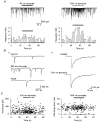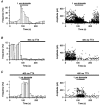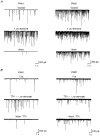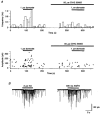Potentiation of GABAergic synaptic transmission by AMPA receptors in mouse cerebellar stellate cells: changes during development
- PMID: 9596802
- PMCID: PMC2230994
- DOI: 10.1111/j.1469-7793.1998.817bm.x
Potentiation of GABAergic synaptic transmission by AMPA receptors in mouse cerebellar stellate cells: changes during development
Abstract
1. The effects of low concentrations of domoate, an agonist at both alpha-amino-3-hydroxy-5-methylisoxazole-4-propionate and kainate receptors (AMPARs and KARs, respectively), were investigated in stellate cells in slices of mouse cerebellum at two developmental stages (postnatal day (PN) 11-13 and PN21-25). 2. Low concentrations of domoate enhanced the frequency of miniature IPSCs (mIPSCs) recorded in the presence of tetrodotoxin (TTX) at PN11-13 but not at PN21-25. 3. The effects of low concentrations of domoate on synaptic activity were probably mediated by the activation of AMPARs and not KARs, since they were blocked by GYKI 53655 (LY300168), a selective AMPAR antagonist. 4. Domoate increased mIPSC frequency in part by activation of presynaptic voltage-dependent Ca2+ channels since potentiation was reduced by 60 % in the presence of Cd2+. AMPARs in stellate cells were found to be permeable to Ca2+. The residual potentiation in the presence of Cd2+ could thus be due to a direct entry of Ca2+ through AMPAR channels. 5. In the presence of TTX, potentiation of synaptic activity by focal application of domoate was not restricted to the region of the cell body, but was observed within distances of 120 micro(m). These experiments also revealed a strong spatial correlation between the location of the presynaptic effects of domoate and the activation of postsynaptic AMPARs. 6. Our data show a developmentally regulated presynaptic potentiation of synaptic transmission between cerebellar interneurones mediated by AMPARs. We discuss the possibility that the developmental switch could be due to a shift in the localization of AMPARs from the axonal to the somato-dendritic compartment.
Figures









Similar articles
-
Functional GluR6 kainate receptors in the striatum: indirect downregulation of synaptic transmission.J Neurosci. 2000 Mar 15;20(6):2175-82. doi: 10.1523/JNEUROSCI.20-06-02175.2000. J Neurosci. 2000. PMID: 10704492 Free PMC article.
-
AMPA receptor-mediated presynaptic inhibition at cerebellar GABAergic synapses: a characterization of molecular mechanisms.Eur J Neurosci. 2004 May;19(9):2464-74. doi: 10.1111/j.0953-816X.2004.03347.x. Eur J Neurosci. 2004. PMID: 15128400 Free PMC article.
-
Presynaptic AMPA and kainate receptors increase the size of GABAergic terminals and enhance GABA release.Neuropharmacology. 2007 Jun;52(8):1631-40. doi: 10.1016/j.neuropharm.2007.03.010. Epub 2007 Mar 24. Neuropharmacology. 2007. PMID: 17493642 Free PMC article.
-
The activation of glutamate receptors by kainic acid and domoic acid.Nat Toxins. 1998;6(3-4):153-8. doi: 10.1002/(sici)1522-7189(199805/08)6:3/4<153::aid-nt16>3.0.co;2-1. Nat Toxins. 1998. PMID: 10223631 Review.
-
The molecular pharmacology and cell biology of alpha-amino-3-hydroxy-5-methyl-4-isoxazolepropionic acid receptors.Pharmacol Rev. 2005 Jun;57(2):253-77. doi: 10.1124/pr.57.2.7. Pharmacol Rev. 2005. PMID: 15914469 Free PMC article. Review.
Cited by
-
Somatic recording of GABAergic autoreceptor current in cerebellar stellate and basket cells.J Neurosci. 1999 Mar 1;19(5):1675-90. doi: 10.1523/JNEUROSCI.19-05-01675.1999. J Neurosci. 1999. PMID: 10024354 Free PMC article.
-
Presynaptic ryanodine-sensitive calcium stores contribute to evoked neurotransmitter release at the basket cell-Purkinje cell synapse.J Neurosci. 2003 Dec 3;23(35):11229-34. doi: 10.1523/JNEUROSCI.23-35-11229.2003. J Neurosci. 2003. PMID: 14657182 Free PMC article.
-
Presynaptic AMPA Receptors in Health and Disease.Cells. 2021 Aug 31;10(9):2260. doi: 10.3390/cells10092260. Cells. 2021. PMID: 34571906 Free PMC article. Review.
-
Current and calcium responses to local activation of axonal NMDA receptors in developing cerebellar molecular layer interneurons.PLoS One. 2012;7(6):e39983. doi: 10.1371/journal.pone.0039983. Epub 2012 Jun 27. PLoS One. 2012. PMID: 22761940 Free PMC article.
-
Modulation of the glycine response by Ca2+-permeable AMPA receptors in rat spinal neurones.J Physiol. 1999 Feb 1;514 ( Pt 3)(Pt 3):701-11. doi: 10.1111/j.1469-7793.1999.701ad.x. J Physiol. 1999. PMID: 9882741 Free PMC article.
References
-
- Altman J, Bayer SA. Development of the Cerebellar System in Relation to its Evolution, Structure and Functions. Boca Raton, FL, USA: CRC Press; 1997.
-
- Ankri N, Legendre P, Faber DS, Korn H. Automatic detection of spontaneous synaptic responses in central neurones. Journal of Neuroscience Methods. 1994;52:87–100. 10.1016/0165-0270(94)90060-4. - DOI - PubMed
-
- Bettler B, Egebjerg J, Sharma G, Pecht G, Hermans-Borgmeyer I, Moll C, Stevens CF, Heinemann S. Cloning of a putative glutamate receptor: a low affinity kainate receptor subunit. Neuron. 1992;8:257–265. - PubMed
-
- Bettler B, Mulle C. AMPA and kainate receptors. Neuropharmacology. 1995;34:123–139. - PubMed
MeSH terms
Substances
LinkOut - more resources
Full Text Sources
Miscellaneous

